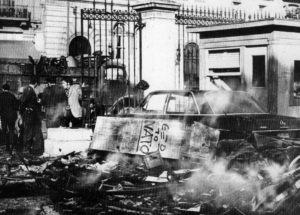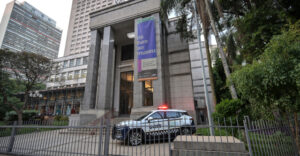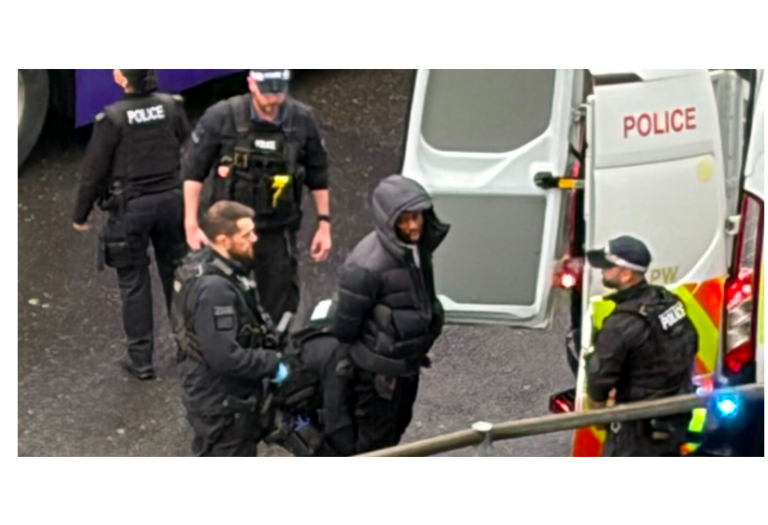The evening of July 23, 1974, Athens was shaken by the celebrations of thousands of people. After seven years of “plaster,” the junta regime was hastily abandoning power, unable to bear the weight of its final act, synonymous with national treason: the tragedy of Cyprus.
As night fell and it became clear that Konstantinos Karamanlis would lead the new chapter of the country, many demonstrators suddenly rushed to the Polytechnic. The night turned into day with countless candles and lanterns, in memory of the victims of the martyrdom of the November ’73 three-day uprising. At that time, no one even knew how many there were. For those who experienced it, the moments were overwhelming. They flowed silently; the chants had ceased.
This was the first evidence that the Polytechnic had already been engraved in the collective consciousness of the Greeks as a symbol of resistance against the tyrannical regime, regardless of personal experience and perceptions. For many who wanted to be part of it in spirit but did not dare, it may also have been an opportunity to absolve their own inertia and passivity toward the dictatorship, not just during that dramatic three-day period, but throughout the entire seven-year junta. That night, the slogan “The Polytechnic lives” was heard for the first time.
Uprising
This year marks 50 years since the anniversary celebrations of the Polytechnic. A student uprising that condensed what they wanted to achieve into three words: “Bread, Education, Freedom.” It began as a university occupation and evolved into a massive anti-junta outburst. This required ideas and people. And it had them. This is how the myth was later built.
It was, of course, the spark for a series of explosive events. It was the beginning, not necessarily the cause, of a sequence of terrifying historical events: Polytechnic – Cyprus – Metapolitefsi (Restoration of Democracy). These events brought democracy back to the land that birthed it, but they also maimed Hellenism for the second time within the same century.
Many theories, assumptions, and questions developed around the “whys” and “ifs” of the Polytechnic. The motives, the purposes, the participation, even the number of victims. But the historical event managed to serve as a legacy for future generations. And it endured. It suffered the wear and tear of exploitation by political parties, each giving its own meaning to the uprising. The left-wing parties were more successful in doing this. For PASOK, it was the ideal way to link generations from a distant dark era to the present, with its raging anti-Americanism and anti-right-wing climate during the early post-dictatorship period, before it settled into the pragmatism of its own governmental future.
For New Democracy, it was a difficult bet, as it constantly reminded of the pre-junta Right’s responsibilities for the seven-year dictatorship. Even though its historical figures played a leading role in dismantling the junta regime. At the same time, the founder of New Democracy, Konstantinos Karamanlis, was facing enormous difficulties and dangers in the process of establishing a truly modern Western democracy in Greece.
Inevitably, over time, the Polytechnic suffered from the wear and tear of political exploitation, as well as the general reaction, criticism, and eventual disillusionment of citizens in the face of the ever-changing political and social conditions. The party colors of the anniversary celebrations and the annual meeting of anarchists and troublemakers for property vandalism—of the Polytechnic itself not excluded—and clashes with the police accelerated the declining participation, but more importantly, the emotional alienation, fear, and even aversion from future generations. A veil of decadent phenomena surrounded the celebrations, threatening the very historical event of the uprising.
This also contributed to the fact that some of the founding figures who built the myth were seen as beginning to cash it in for positions and careers. Then the legend transformed into an earthly event. The flame of change became a reserve and suspicion. The great principles and ideals lost much of their luster.
Closing
Nevertheless, it has not (at least yet) been demystified. Even though the famous “generation of the Polytechnic,” now retirees, struggles to balance successes and failures, which were probably credited and blamed too easily, the Polytechnic itself remains a symbol of mass, genuine resistance by the youth, the pinnacle of an era against the dictatorial regime.
Despite many, in a recent Metron Analysis survey, 76% of respondents considered the Polytechnic an expression of mass resistance against the dictatorship rather than a limited-scale event, and 81% thought it contributed greatly to the fall of the junta. 61% (compared to 33%) positively assessed the impact of the Polytechnic generation and the protagonists of the events.
The First Anniversary
The first anniversary of the Polytechnic uprising coincided with the first post-junta free elections. Many believed Konstantinos Karamanlis chose this date, fearing incidents and other risks in the early steps of the country’s democratic path. Many “unrepentant” were lurking to derail it at every opportunity.
Naturally, gatherings were banned, and the celebration was moved to the weekend of November 22-24. Left-wing student organizations reacted strongly. They ignored the ban and, on Friday, the 15th, organized a massive gathering at the Polytechnic and then a march via Alexandra Avenue to the Kaisariani Shooting Range.
At the same time, the final pre-election rally of the newly-formed New Democracy was taking place in Syntagma Square, with Konstantinos Karamanlis as the speaker. The authorities’ greatest fear was that some provocation might occur. Despite the efforts of the disorderly, nothing happened.
From the ballot boxes, a clear message emerged: the overwhelming 54.37% for New Democracy. It left no doubt about what the Greeks wanted at that moment—the consolidation of the long-suffering Democracy, and then the country would begin to heal its other wounds.
The official celebration had few party flags and a lot of spontaneity. With countless wreaths in the yard and bouquets, poems, sketches, and paintings on the institution’s gates. With Giannis Ritsos reciting verses from “Romiosyni,” Maria Farandouri and Nikos Xylouris singing “When will it be clear” from the balcony of the Architecture building, amidst the slogans filling the air. What slogans? “Give the junta to the people,” “NATO is treason,” and other similar ones.
Almost one million people participated in the march to the American Embassy. In the literal sense, a massive crowd and great passion. The destination was chosen because of the U.S. involvement in the path of the dictatorship as well as in the tragedy of Cyprus. Twenty-five years later, Bill Clinton’s public apology at the Presidential Mansion on Herod Atticus Street came to respond to any doubts.
Greek and international news agencies described it as a mammoth march. Non-partisan, unifying, enthusiastic, peaceful. They would never see it again. It also had a strong anti-monarchy tone. Already, Konstantinos Karamanlis had announced a referendum on December 8 to resolve the issue of the monarchy. The demonstrators made their point, a harbinger of the 69% that followed in favor of a republic.
The Reports of Ambassador Kubiš
In the first years, anti-Americanism dominated all the celebrations of the anniversary. It is interesting to examine how the American side viewed this atmosphere in an allied country, which, however, by decision of Konstantinos Karamanlis, had withdrawn from NATO’s military wing because of “Attila 2.” Specifically, how the American embassy in Athens assessed the events, the climate, and the resulting dangers before and after each anniversary celebration. Ambassador Jack Blum Kubiš, successor to the infamous Henry Taska, was in charge.
Many of these details surfaced through WikiLeaks in the famous Public Library of US Diplomacy. Specifically, what was contained in Kubiš’s document (74ATHENS8198) from Thursday, November 14, 1974, with the heading “Fears of student unrest before the elections.” Recipients included the State Department and NATO’s military command in Europe.
The ambassador referred to “rumors in party headquarters that extremists hope to cultivate an atmosphere at the Polytechnic rally to provoke unrest at the New Democracy pre-election rally, a mile away, with the ultimate goal of provoking clashes with security forces to influence the timing of the elections.” He estimated that “the myth of the Polytechnic uprising in relation to political developments in Greece has gained great power.”
In a subsequent document (74ATHENS8359), in preparation for the official celebration, Kubiš expressed concern about the prevailing anti-American spirit: “The celebration has been given a distinct political hue by the Marxist-oriented student organizing committee. It aims at complete withdrawal from NATO, the permanent removal of U.S. and NATO bases, the resolution of the Cyprus issue based on UN decisions, and the punishment of those responsible for April 21, November 17, and July 15 (the day of the coup in Cyprus).”
The famous “Moutza”
In his final report (74ATHENS8419), he estimated that “the climax of the events was the march of 200,000-300,000 Greeks from the Polytechnic to the American embassy, where the demonstrators were shouting ‘Americans out’ and making the five-fingered derogatory Greek gesture, known as the ‘moutza’ […] The purely Marxist exploitation of the commemoration gave it an anti-American tint, linking the official American presence with the torturers of the ESA, the slaughterers of the Polytechnic and the coup plotters in Cyprus.”
A year later, on November 18, 1975, after the second anniversary, Kioubi reported (1975ATHENS8955) that “the violence and bloodshed at the Polytechnic in Athens two years ago had become a national symbol in the eyes of the Greeks, especially the youth. The vast majority of Greeks, who did nothing to oppose the junta, now honor the Polytechnic anniversary, the only specific instance of resistance to the junta. And by celebrating it, they partially atone for their consent to the seven-year military dictatorship.” How much truth was there in this statement?
Ilenia, the first blow
The story of Ilenia, at the very first anniversary of the Polytechnic, amid a highly charged emotional atmosphere, was an initial attempt to distort the nature of the uprising.
At one point, among wreaths and bouquets, there was a sketch of a beautiful girl. Next to it, a handwritten note: “Her name is Ilenia Asimakopoulou. She is my girl. She disappeared the night of the massacre. No one has seen her again. I went to her house, but her parents are missing too. Anyone who knows about her tragic end, please let me know.”
An excellent heartbreaking narrative, with the newspapers writing: “‘What happened to my Ilenia?’: The tragedy of a boy still searching for his murdered girl.” Details followed. The young man mentioned that they were together at the Polytechnic, and after the invasion, they left through the Stournari gate, where an armed man shot her in the back at point-blank range. She leaned on him, bleeding from the mouth, before collapsing. He was arrested. When he was released months later, he searched for her parents and younger brother in Chalandri, but they had disappeared. However, he did not testify to the prosecutor-investigator for the Polytechnic events, Dimitris Tsevas, because he was afraid.
So what happened to Ilenia? No one knew. But the girl in the sketch was not any… Ilenia. The sketch was stolen from a shampoo advertisement by the English company Breck. It had been published in the English edition of “Vogue.” The creator was the renowned portrait artist Nicholas Igon, with the model being New Zealander Nancy Kridland. Her name was not Ilenia, she had lived in London since she was 4, and she was never murdered outside the Polytechnic.
With the revelation of the glaring fraud, the perpetrator, a student of the Electrical Engineering School, Giannis Iliopoulos, was taken to court. On February 18, 1975, he was sentenced to eight months in prison.
The criminal offense was secondary. The major issue was that this vile forgery, if not intentional, opened the appetite for all kinds of detractors of the Polytechnic uprising to tarnish it.
In their haste, however, they exposed themselves irreparably. They declared one of the victims of disinformation to be Ioanna Tsatsou. They discovered that “in memory of Ilenia, the most wreaths were laid, with the first and best being that of Ioanna Tsatsou—wife of the then President of the Republic—who even knelt in front of the sketch and wept.” But Konstantinos Tsatsos was elected President of the Republic on June 19, 1975, four months after Iliopoulos’ judicial conviction.
The two deaths in 1980
Two black anniversaries of the Polytechnic uprising remain in history, as they were accompanied by the murders of demonstrators. The first in 1980. The Rallis government banned the march to the American embassy. A month earlier, it had announced the country’s return to NATO’s military wing. The opposition’s reaction was rather subdued, as elections were approaching.
The march of the National Student Union of Greece (EFEE) was completed smoothly around 8:30 p.m. The atmosphere, however, was strange. Shortly after, while the procession blocks were dispersing at Syntagma, about 3,000 people, mostly from the extra-parliamentary Left, attempted to move toward Vasilissis Sofias, breaking through the police cordon.
A clash and pandemonium followed. There were hand-to-hand battles, with particular brutality from the MAT against the demonstrators, indiscriminately. The incidents lasted for hours and were fueled when the rumor spread that there were dead protesters.
The rumors were true. 24-year-old Cypriot law student Iakovos Koumis, hit in the head by a police baton, was taken to the Laiko hospital clinically dead. He had been in the march with the Cyprus Self-Determination Committee. According to witnesses, he did not participate in the clashes but was sitting in a café in the Metochiko Army Fund arcade. He died on November 23.
That same night, 21-year-old worker Stamatina Kanelopoulou also fell in Panepistimiou, bleeding from repeated baton blows by the police. She was taken unconscious to Hippokrateio, where she died before doctors could provide first aid. The forensic report was shocking: 18 blows to the skull, multiple fractures, severe cranio-cerebral injury.
The government blamed the demonstrators for the incidents. It ordered an internal investigation to assign responsibility for the two deaths, but the culprits were never found. Neither did the lawsuits from the victims’ relatives yield anything. A week later, in Parliament, Prime Minister Georgios Rallis made a historic statement: “Even Archangel Michael holds a sword in his hands to defend against demons. He does not hold flowers.”
However, politically, the first statement by Andreas Papandreou came as a surprise to all: “Small groups of irresponsible elements and provocateurs of unknown and suspicious origin created tragic incidents with the obvious aim of tarnishing and discrediting the great popular anniversary of the Polytechnic.” A sign of his retreat ahead of the elections.
The Kaltezas case
The next dark moment was in 1985. PASOK, with a fresh second popular mandate (June 2), had implemented austerity measures as the economy was in turmoil. In this climate, for the first time, President of the Republic Christos Sartzetakis laid a wreath on the anniversary of the Polytechnic.
The march, with around 150,000 participants, was peaceful. But the night was long. Suddenly, small clashes broke out between the police and anarchists near the Polytechnic. And at one point, the unexpected happened. 27-year-old policeman Athanasios Melistas, inside a parked MAT vehicle on Stournari Street, panicked when he saw a Molotov cocktail thrown that broke a window. He fired. 15-year-old Michalis Kaltezas was 20 meters away. According to the Greek Police, he was about to throw a Molotov cocktail at the vehicle. The bullet hit him in the head.
The news of the murder and the photograph of a dead child the next day shocked everyone. In practice, it led to the occupation of the old Chemistry building on Solonos Street. The University of Athens Asylum Committee, with President Michalis Stathopoulos and student representative Giannis Tsamourgelis from the Panhellenic Revolutionary Student Union (PASSP, aligned with PASOK), granted police forces permission to enter the Chemistry building.
A clash followed. This was the first lifting of the asylum since its establishment by PASOK’s government in 1982. Meanwhile, for reasons of personal honor, Minister of the Interior and Public Order Menios Koutsogiorgas and his deputy Thanasis Tsouras resigned. The Prime Minister did not accept them. However, he left the Greek Police without leadership, placing three of its top and most capable officials—Georgios Romosios, Manolis Bosinakis, and Stylianos Tzanakis—on suspension.
Ten days later, in retaliation for Kaltezas’ murder, 17N carried out a bomb explosion in a car bomb near a MAT vehicle at the “Caravel” hotel. Policeman Nikos Georgakopoulos was killed, and 14 people were injured. Perpetrators included Vasilis Tzortzatos, Dimitris Kofontinas, and Christodoulos Xiros. The senior officers returned to the force, but it was too late.
Melistas was initially sentenced to two and a half years in prison with a suspended sentence, and in the second trial, he was acquitted on January 26, 1990, by the Mixed Jury Court of Appeal with a 6-1 vote.
PASP’s “Property” Flag
One of the most emblematic symbols of the uprising is consistently at the forefront of the Polytechnic march. The bloodstained flag that was waved by one of the protesters, who remained in place at the Patission gate until the tank invasion. This event was captured by Dutch journalist Albert Kourant, who was in his hotel room at the “Acropol.”
What few know is the later fate of this flag. A ghost symbol that suddenly appears in the lead of the march by members of PASP and when it reaches the American embassy, it magically disappears. Until the next anniversary…
It remains, that is, in the hands of a student faction, which invokes reasons of… security. Logically plausible, perhaps, as all kinds of troublemakers and other well-wishers are lurking everywhere. However, in any case, its place is elsewhere.
Some photos depicted the bloodstained flag in the hands of commandos. The fact is that the day after the events, some handed it over to the offices of the newspaper “Vradyni” in Omonia. Its publisher, the late Tzortis Athanasiadis, took responsibility for keeping it safe. He never revealed how it came into his hands.
After the Metapolitefsi, initially, the Central Council of the National Union of Students of Greece (EFEE) was responsible for it. In the first period of the marches, carrying the flag was a huge honor. From the four points from which it was held, equal representatives of student factions marched, building political careers of great significance: Stefanos Tzoumakas, Christos Papoutsis, Chrysanthos Lazaridis, Stavros Kontonis, Pavlos Polakis, the list is long.
The flag passed into the possession of PASP before 1980. During Papoutsis’ presidency in EFEE, it was continually kept in the homes of top PASP figures. In 2008, the then secretary of PASOK, Giannis Ragkousis, although he announced that it would be handed over to Parliament, ultimately accepted the grand refusal of the PASP members.
In 2021, in a statement, the Association of Imprisoned and Exiled Resistance Fighters 1967-1974 (SFEA) asked the guardians of the Polytechnic flag to hand it over for display at the Museum of Anti-Dictatorship Democratic Resistance. They did not hand it over.
The bronze head
To the right of the central gate, in the precinct of the Polytechnic, stands the bronze head of the monumental sculpture on which wreaths are laid every year. Next to it, the iron gate that the tank knocked down. The head symbolizes the student uprising, something like the “anonymous fighter.”
However, it is not related to the youth of 1973. It depicts the historian Nikos Svoronos. The creator was the prominent sculptor Memmos Makris, a close friend and fellow ideologue of Svoronos. He was born in 1913, studied at the Athens School of Fine Arts, and during the German occupation, he developed resistance activities. After liberation, he continued his studies in Paris. He was expelled from France in 1950 and sought political asylum in Hungary. He lived there for many years and established himself as one of the sculptors with compositions in the spirit of socialist realism. In 1964, his Greek citizenship was revoked. He regained it in 1975 after the restoration of democracy.
The sculpture was placed at the Polytechnic a few years after the Metapolitefsi, during the rectorate of Georgios Voudouris, a member of the KKE and also a personal friend of Makris. Nikos Svoronos, whom it depicts, was born in 1911. He studied at the Philosophical School of Athens. Although from a Venizelist family, during the occupation, he joined the ranks of EAM and ELAS. In December 1945, with a scholarship from the French Republic, he left for France aboard the ship “Mataroa.” On the journey, he met Makris. In Paris, he studied Philology and History at the Ecole Pratique des Hautes Etudes and Ecole des Langues Orientales. In 1955, his Greek nationality was revoked, and in 1961 he obtained French citizenship. He returned to Greece after the dictatorship and taught at the Universities of Thessaloniki and Crete.
Periods and milestones
The celebrations of the Polytechnic anniversary can be divided into four periods, depending on the political and social conditions at the time. The first, between 1974-1981, was the period of mass events. Another student celebration. Of course, party politicization gradually entered. In 1978, a delegation from Parliament participated, and ONNED was also present in the demonstration.
From 1981, with PASOK’s rise to power, the anniversary acquired institutional status. A holiday for the entire education system. Wreaths from the entire political leadership, starting with the Prime Minister, the Speaker of the Parliament, and later (1985) from the President of the Republic, from the leaderships of the Greek Police and the Armed Forces. However, the events, especially the march, were always a field for party confrontation.
It was the battle for impressions, far from the meaning and legacy of the Polytechnic. With Homeric quarrels over the… tables of student factions, to the blocks in the marches, which, with their arrangement and slogans, competed for the image. In the ’81 march, the battle was dominated by “the struggle now is justified” vs “the struggle now continues.” The “greens” demonstrating against everyone.
Gradually, the anarchists’ blocks entered the scene, testing the endurance of the other demonstrators and the police, turning the three-day period more into a trial of fear and unrest. At the same time, outside the Polytechnic, during the three-day period, a small fair with street vendors was set up, intensifying the unpleasant image.
In 1991, the celebration took place against the sad backdrop of the burned Rector’s office at the Polytechnic from October 26, with “angry citizens” clashing with anarchists in the streets around the institution. Between 1993-2009, the events gradually lost their once-popular character, seeming more like a formal fulfillment of duties by organizations and parties. At one point, the police forces outnumbered the demonstrators. The fear of the incidents that usually followed diminished the essence of the anniversary.
In the 1995 celebration, there were multi-day incidents, with the Polytechnic being occupied and evacuated through a police operation. The largest number of arrests in history occurred, with 472 people detained. In 2002, the march included Marie Therese Peino and Alicia Romero Cortez, companions of Alexandros Giotopoulos and Savvas Xiros, who had been arrested as members of 17N. How could they not, since for almost 28 years, the organizers had failed to do what was necessary to disown the completely provocative appropriation of the date by the terrorist organization.
In the last period, 2010-2023, another painful development occurred. The country’s bankruptcy and the memoranda, instead of rejuvenating the positive imprint of the Polytechnic uprising, opened the floodgates of complete disapproval. Many took the opportunity to attribute heavy—and likely excessive—responsibilities for the economic deadlock and social turmoil Greece experienced to those politicians who emerged from the events of ’73 and, subsequently, to the entire Polytechnic generation.
It is no coincidence that the celebrations remained without significant participation, the marches were also framed by immigrant organizations and the few party blocks, which insisted on self-congratulation and praise of themselves.
Ask me anything
Explore related questions





